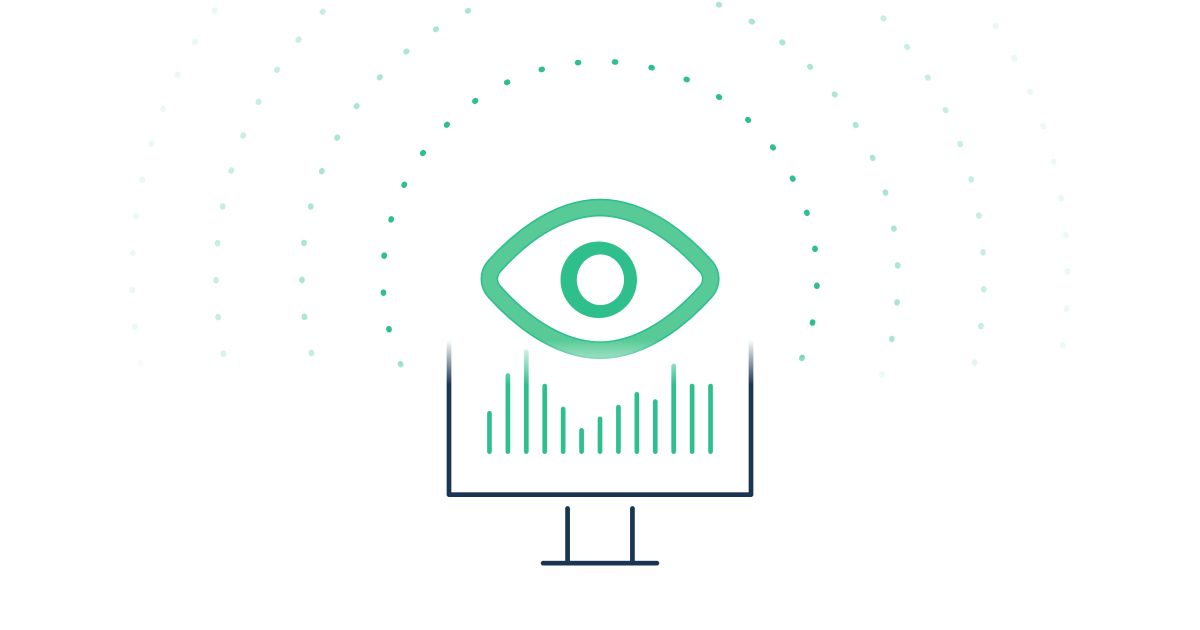Table of Contents
Table of Contents
Are you tired of constantly running back and forth to check the status of your network devices? Do you wish you had a magic wand that could tell you everything you need to know about your network at a glance? Well, unfortunately, we can't give you a magic wand, but we can give you something pretty close: SNMP monitoring!
When you’re looking to monitor and optimize network performance, monitoring the performance of networking devices, such as firewalls, routers, switches and wifi access points, using SNMP polling is crucial.
In this post, we'll be diving into the world of SNMP and showing you how to use it to keep an eye on your network like a boss. So sit back, grab a cup of coffee (or your beverage of choice), and get ready to learn about what SNMP monitoring is and how to use SNMP monitoring to optimize network devices.
First, let's start with the basics.
SNMP stands for Simple Network Management Protocol. It is a protocol used for managing and monitoring network devices such as routers, switches, servers, printers, and more. SNMP allows network administrators to collect information about the performance, availability, and usage of network devices, as well as to configure and control them remotely. The first SNMP standard, called RFC, was first published in May 1990 and has greatly evolved since then. Although there are now other telemetry protocols that exist, SNMP remains the base protocol supported by the majority of network equipment.
SNMP operates by sending messages, known as "protocol data units" (PDUs), between SNMP agents (running on network devices) and SNMP managers (running on monitoring systems). The PDUs contain information about the device's status, configuration, and performance, which can be used by the SNMP manager to monitor and manage the device.
SNMP is a widely used network monitoring protocol, and is supported by most network devices and monitoring systems. It is a simple, efficient, and effective way to keep track of your network and ensure that everything is running smoothly.
SNMP monitoring is the process of using SNMP to collect and analyze data from network devices in order to monitor their status, performance, and usage. SNMP monitoring involves two main components: SNMP agents, which are installed on network devices to collect and transmit data, and SNMP managers, which receive and process the data from the agents.
SNMP monitoring allows network administrators to keep track of a wide variety of metrics related to network devices, such as CPU usage, memory usage, network traffic, and more. By monitoring these metrics, administrators can identify potential issues before they become critical, troubleshoot problems quickly, and optimize the performance of their network.
SNMP monitoring can monitor devices such as:
- Routers
- Switches
- Firewalls
- Servers
- Wifi APs
- And other devices that are SNMP enabled
SNMP monitoring can be performed using a variety of tools, ranging from simple command-line utilities to complex network monitoring software. Many network monitoring tools include SNMP monitoring capabilities as a core feature, making it easy to get started with SNMP monitoring even for those with limited experience in network management.
Don't let network issues sneak up on you – be a hero and take control with Obkio! With our easy-to-use SNMP monitoring feature, keep an eye on your network like a boss and stay ahead of the game. So what are you waiting for?

And unleash your inner network superhero with Obkio!

- 14-day free trial of all premium features
- Deploy in just 10 minutes
- Monitor performance in all key network locations
- Measure real-time network metrics
- Identify and troubleshoot live network problems

SNMP monitoring isn't just for tech wizards and networking gurus – it's for anyone who wants to keep their network running smoothly and avoid those dreaded 'network down' moments. From optimizing performance to troubleshooting problems and even generating compliance reports, SNMP monitoring is a superhero tool that can save the day (and your sanity).
SNMP monitoring is used for a variety of purposes related to network management and monitoring. Some common use cases include:
- Device monitoring: SNMP monitoring is used to monitor the status and performance of network devices such as routers, switches, servers, and printers. By monitoring key metrics such as CPU usage, memory usage, and network traffic, administrators can identify potential issues and take corrective action before they become critical.
- Performance optimization: By collecting and analyzing data on network performance, administrators can identify areas where performance could be improved, such as bottlenecks in network traffic or overloaded servers. With this information, they can make targeted improvements to optimize the performance of the network.
- Fault detection and troubleshooting: SNMP monitoring can help administrators quickly detect and diagnose faults in network devices. By monitoring devices in real-time, administrators can receive alerts when issues arise, enabling them to troubleshoot problems and resolve them quickly.
- Capacity planning: By collecting data on network usage over time, administrators can identify trends and forecast future network capacity needs. This allows them to plan for future growth and ensure that the network can support the needs of the organization.
- Compliance and reporting: SNMP monitoring can be used to ensure compliance with industry regulations and internal policies. By collecting data on network activity, administrators can generate reports that show compliance with various requirements, such as data retention policies or security standards.
Overall, SNMP monitoring is a powerful tool for network administrators, providing a wealth of information on network performance and usage that can be used to optimize network operations, troubleshoot problems, and ensure compliance with policies and regulations.
When it comes to SNMP monitoring, there are several network devices that you should consider monitoring in order to ensure the overall health and performance of your network. Some of the most important network devices to monitor with SNMP include:
- Routers: Routers are critical network devices that connect different segments of a network and direct traffic between them. By monitoring routers with SNMP, you can track metrics such as CPU usage, memory usage, and network traffic, which can help you identify potential bottlenecks or issues that could impact network performance.
- Switches: Switches are used to connect devices on a local network and direct traffic between them. By monitoring switches with SNMP, you can track metrics such as port utilization, link status, and error rates, which can help you identify potential issues and optimize network performance.
- Servers: Servers are the backbone of many networks, providing critical services such as file sharing, email, and application hosting. By monitoring servers with SNMP, you can track metrics such as CPU usage, memory usage, and disk space utilization, which can help you identify potential issues that could impact server performance or availability.
- Firewalls: Firewalls are used to protect networks from unauthorized access and attacks. By monitoring firewalls with SNMP, you can track metrics such as CPU usage, memory usage, and traffic levels, which can help you identify potential security issues or performance bottlenecks.
- Printers: Printers are often overlooked as critical network devices, but they can be a significant source of network traffic and downtime. By monitoring printers with SNMP, you can track metrics such as paper and toner levels, error rates, and print job status, which can help you identify potential issues before they become critical.
Overall, monitoring these key network devices with SNMP can help you ensure the overall health and performance of your network, identify potential issues before they become critical, and optimize network operations for maximum efficiency


Monitoring network devices is critical for maintaining the health and performance of your network. Network devices such as routers, switches, and servers are responsible for routing traffic, managing connections, and providing access to network resources. Any issues with these devices can lead to downtime, slow network speeds, and potential security threats.
By monitoring network devices, you can gain insight into their performance and identify potential issues before they become critical. For example, monitoring bandwidth usage can help you identify potential bottlenecks or bandwidth-intensive applications that could impact network performance. Monitoring CPU usage and memory usage can help you identify potential performance issues on network devices such as routers, switches, and servers. Monitoring disk space utilization can help you identify potential issues with storage capacity on servers or other network devices.
In addition to identifying potential issues, monitoring network devices can also help you optimize network operations for maximum efficiency. For example, monitoring network traffic can help you identify potential congestion or bottlenecks on the network, as well as potential security threats. Monitoring uptime can help you identify potential issues with network devices that may be experiencing downtime or other availability issues.
Although SNMP has the word “simple” in it, it may have been simple at the beginning, but it’s greatly complexified over time. Unless you play around with SNMP a lot, or you specialize in it, it’s not easy to use or understand.
Because of this overcomplication, Obkio Network Performance Monitoring software were looking for a way to make SNMP monitoring easy again with a focus on network performance monitoring and troubleshooting.
If you're looking into how to use SNMP, or to use an SNMP monitoring tool, the Network Device Monitoring feature inside of Obkio’s Network Monitoring Software is a fast and easy solution to get detailed information about the health of your core network devices.
Used with the end-to-end Network Performance Monitoring feature, Network Device Monitoring with SNMP Polling helps IT teams quickly and proactively pinpoint issues with devices like firewalls, routers, switches and wifi access points.

Many Network Device Monitoring tools, like Obkio, use SNMP monitoring within their Network Device Monitoring features.
- Obkio's Network Performance Monitoring tool sends an SNMP request to a device, asking it to provide information about a specific metric, such as CPU usage, bandwidth utilization, or uptime.
- The device receives the request and responds with the requested information, which is sent back to Obkio.
- Obkio's app collects the information from the device and stores it in a database, where it can be used for analysis and reporting.
- Obkio can then use this information to identify issues, troubleshoot problems, and optimize the performance of the network and its devices.
SNMP Polling typically operates on a scheduled basis. Obkio sends requests to devices at regular intervals (e.g. every 30 seconds ), and collects the responses over time to create a historical record of performance metrics. This allows you to track changes over time and identify trends that may indicate potential issues or opportunities for optimization.
With Obkio, you don’t need to establish VPNs between a centralized monitoring server and the LANs where the network devices are located because all the SNMP polling is already done by Obkio’s Monitoring Agents.
Before you can begin monitoring your network devices with SNMP monitoring, you need to deploy at least one Monitoring Agent.
Monitoring Agents are a unique software developed by Obkio to monitor network performance in key network locations (data centers, branch offices, clouds etc.). They continuously exchange synthetic traffic in your network to measure performance using key network metrics, and identify performance issues.
You need a Monitoring Agent deployed so that it can communicate with your network device to measure performance. We always recommend using the Agent closest to the device you want to monitor.
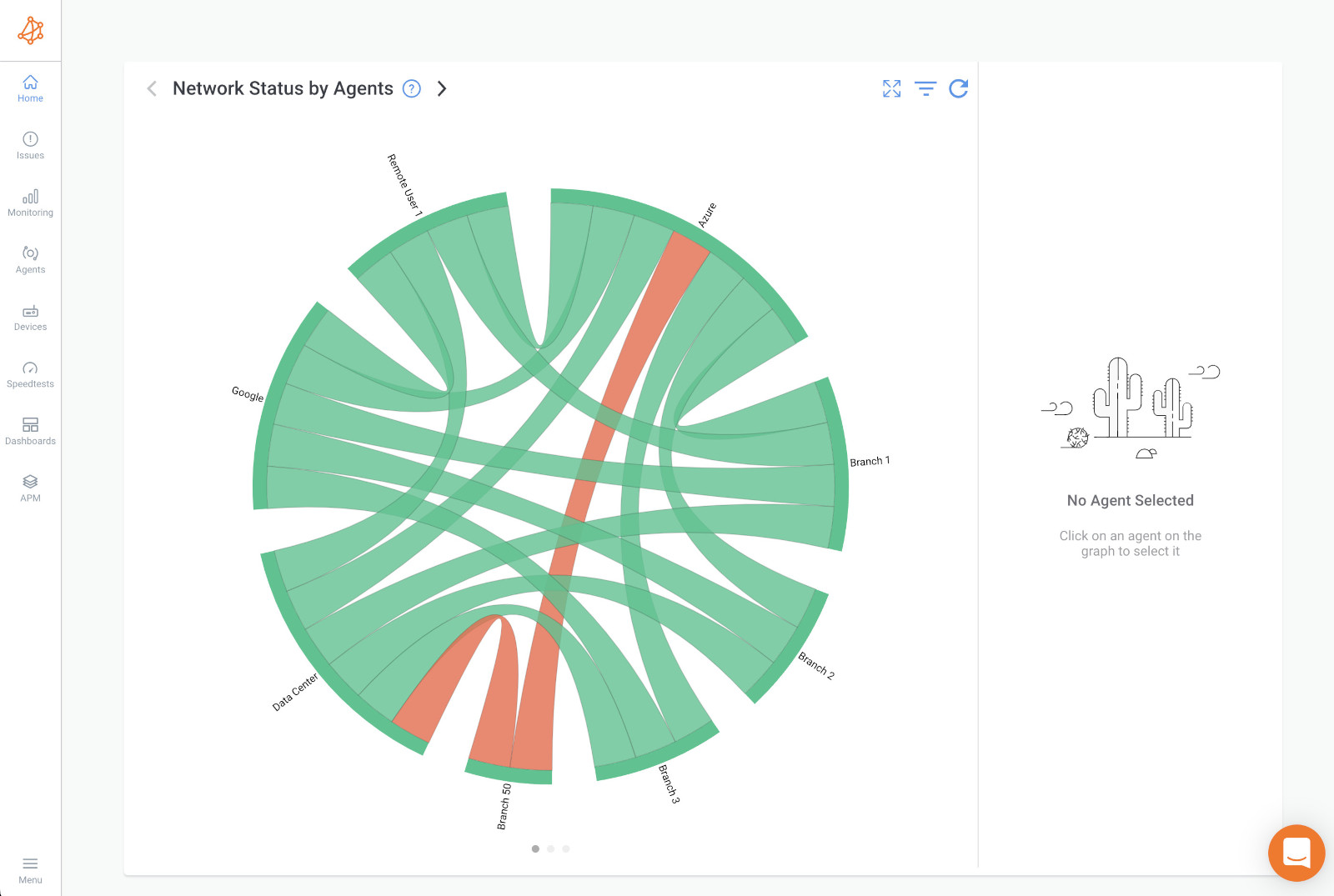
Once you’ve installed your monitoring agents, start monitoring your network devices using SNMP by adding the devices inside the Obkio App.
The device must support SNMP. Obkio supports all versions of SNMP (v1, v2c and v3) and of course, a read-only access is needed. Learn more about the supported devices here.
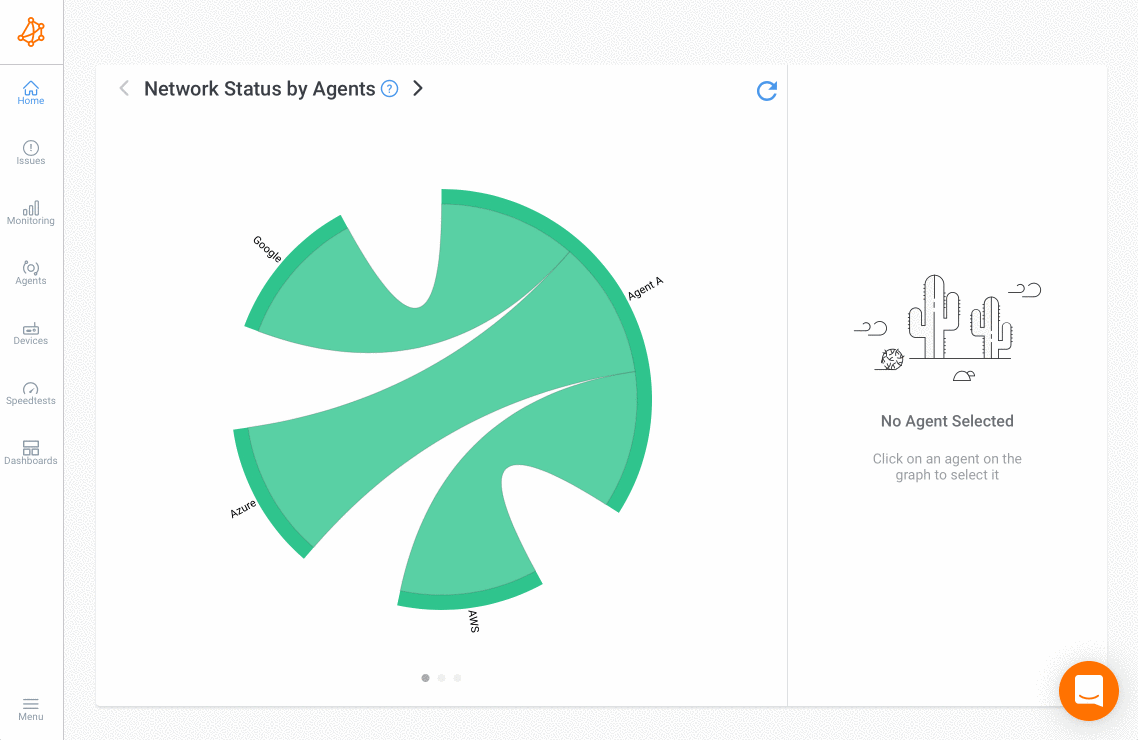
No technical expertise in SNMP and OID Detection is required. Once you add your devices, Obkio’s network device monitoring feature adapts to any time of equipment.
For example, whether you’re using a Meraki router, Cisco, Fortinet or SonicWall - Obkio will collect the appropriate information for that equipment in order to monitor the device and identify performance issues.
Once you’ve added your network devices, Obkio’s Network Device Monitoring features uses Ultra-Fast Polling (every 30 seconds) to provide results that are far more precise than the traditional software polling, which occurs every 5 minutes.
This frequency more accurately detects short bursts of traffic (packet bursts) or CPU utilization that affect network performance and identifies the root cause of the performance issue.
Traditional network monitoring software polling, which is every 5 minutes, hides the peaks that actually help in pinpointing performance issues.
Once you’ve deployed Obkio and added your network devices, Obkio will begin continuously monitoring key network device performance metrics that give you a complete overview of the health of your network deivces. When it comes to SNMP monitoring, there are several network device metrics that you should consider monitoring in order to ensure the overall health and performance of your network.
Here are some of the most important network device metrics to monitor with SNMP:
- Bandwidth usage: Monitoring bandwidth usage can help you identify potential bottlenecks or bandwidth-intensive applications that could impact network performance.
- CPU usage: Measuring CPU usage can help you identify potential performance issues on network devices such as routers, switches, and servers.
- Memory usage: Monitoring memory usage can help you identify potential performance issues on network devices such as routers, switches, and servers.
- Disk space utilization: Monitoring disk space utilization can help you identify potential issues with storage capacity on servers or other network devices.
- Network traffic: Monitoring network traffic can help you identify potential congestion or bottlenecks on the network, as well as potential security threats.
- Error rates: Monitoring error rates can help you identify potential issues with network devices such as switches or routers, as well as potential issues with cables or connectors.
- Uptime: Monitoring uptime can help you identify potential issues with network devices such as routers, switches, and servers that may be experiencing downtime or other availability issues.
By monitoring these key network device metrics with SNMP, you can gain insight into the health and performance of your network, identify potential issues before they become critical, and optimize network operations for maximum efficiency.
Once you’ve deployed Obkio's SNMP monitoring feature and added your network devices, Obkio will begin continuously monitoring network device performance.
By continuously monitoring network device performance, Obkio can identify common issues related to network devices. For example, it can detect issues such as high CPU usage, excessive packet loss, interface errors, CRC errors, and other performance issues that can impact the overall health and performance of your network.
There are several common network device issues that can impact the performance and reliability of your network. Here are a few examples:
- High CPU Usage: Network devices such as routers and switches can experience high CPU usage due to resource-intensive processes or applications. This can lead to slow performance and degraded user experience.
- Interface Errors: Network interfaces such as switch ports or router interfaces can experience errors related to data transmission, such as packet drops, discards, or errors related to network cables. This can result in connectivity issues and degraded performance.
- Bandwidth Congestion: Network devices can experience network congestion due to high traffic volume, leading to slow performance, dropped packets or network overload.
- Firmware or Software Bugs: Network devices can experience bugs or issues related to their firmware or software, leading to unexpected behavior or degraded performance.
- Hardware Failure: Network devices can experience hardware failure due to age, wear and tear, or other factors, leading to outages or degraded performance.
- Misconfigurations: Network devices can experience issues due to misconfiguration, such as incorrect routing or QoS settings, leading to connectivity issues and degraded performance.
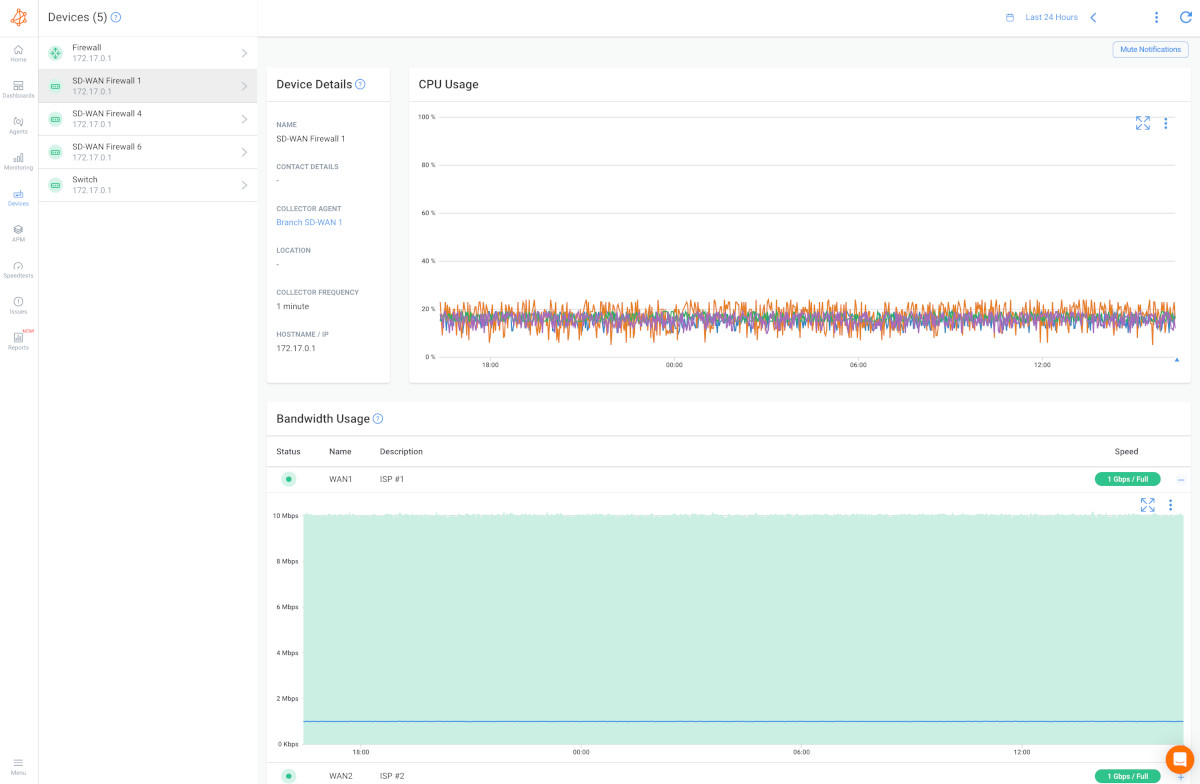

Obkio uses this data to provide insights and network monitoring alerts that can help you quickly identify and resolve network device issues. For example, it may alert you if a device is experiencing high CPU usage, which could indicate a process or application that is consuming too many resources. Or it may alert you if a device is experiencing excessive packet loss, which could indicate network congestion or other issues.
Overall, by continuously monitoring network device performance, Obkio can help you maintain the health and performance of your network, proactively identify potential issues, and take action to prevent or resolve them before they impact your users.
Obkio's Device Monitoring feature has three great advantages when compared with other SNMP monitoring tools on the market:
Compared to most device monitoring and SNMP monitoring tools on the market, SNMP monitoring with Obkio is easy.
No technical expertise in SNMP and OID Detection is required. That’s because Obkio’s device and SNMP monitoring feature adapts to the type of equipment to monitor:
- CPU Usage
- Bandwidth Interface Errors
- Interface Errors
- Device Availability
- CRC Errors
- Interface Duplex
No matter the type of equipment.
For example, whether you’re using a Meraki router, Cisco, Fortinet or SonicWall - Obkio will collect the appropriate information for that equipment in order to monitor the device and identify performance issues.
Obkio offers SNMP monitoring with Ultra-Fast Polling (every 30 seconds), which provides results that are far more precise than the traditional software polling, which occurs every 5 minutes.
This frequency more accurately detects short bursts of traffic or CPU utilization that affect network performance and identifies the root cause of the performance issue. Traditional network monitoring softwares polling, which occurs every 5 minutes, hides the peaks that actually help in pinpointing performance issues.

With Obkio, you don’t need to establish VPNs between a centralized monitoring server and the LANs where the network devices are located because all the polling is done by Obkio’s Monitoring Agents.
When setting up Obkio, you deploy Network Monitoring Agents inside the LAN which continuously measure end-to-end network performance.
This feature is especially helpful for MSPs looking to deploy SNMP monitoring!
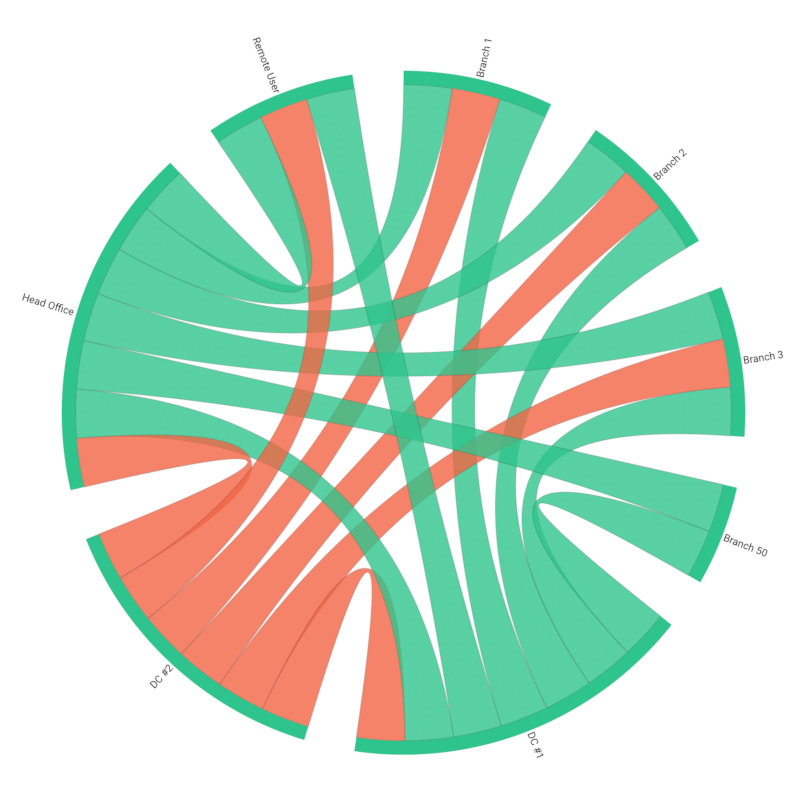
SNMP monitoring can be a useful tool for monitoring the health and performance of SD-WAN (Software-Defined Wide Area Network) deployments.
SD-WAN is a network technology that enables organizations to connect multiple locations, data centers, and cloud services over a single, secure, and agile network. With SD-WAN, network traffic can be intelligently routed across multiple paths, based on factors such as application type, network availability, and cost.
Monitor all SD-WAN networks like:
To effectively monitor SD-WAN, it is important to monitor key network device metrics such as bandwidth usage, network traffic, and application performance across all paths. This is where SNMP monitoring comes in.
By using SNMP to monitor key network device metrics on SD-WAN routers, switches, and other devices, network administrators can gain real-time visibility into the performance of the SD-WAN network. SNMP can provide detailed information on network traffic, bandwidth usage, CPU and memory utilization, error rates, and other critical metrics.
This information can be used to identify potential issues with SD-WAN performance, such as congestion, packet loss, or network latency. With this insight, network administrators can take proactive steps to optimize SD-WAN performance, such as adjusting routing policies, prioritizing critical applications, or adding additional network capacity.

SNMP monitoring is a powerful tool for monitoring the health and performance of your network devices. By leveraging SNMP monitoring, you can gain real-time visibility into critical network metrics such as bandwidth usage, network traffic, and application performance. This insight can help you identify potential issues before they become critical, optimize network operations for maximum efficiency, and ensure maximum uptime.
If you're looking for an SNMP monitoring tool that is easy to use, reliable, and provides actionable insights, consider trying Obkio. With Obkio, you can monitor key network device metrics and receive real-time alerts and notifications when performance issues are detected. Plus, setting up SNMP network device monitoring with Obkio is easy!

So, whether you're a network administrator, IT manager, or just someone who wants to ensure maximum uptime and network performance, SNMP monitoring is an essential tool to add to your toolkit.
And start gaining valuable insight into the health and performance of your network!



























 Obkio Blog
Obkio Blog





